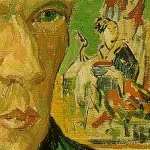
One rather obvious aspect of writing a historical novel--an aspect non-writers can easily appreciate--is all the research, both on large matters and small, that goes into it. (It's the research on small matters that's actually the hardest, as some of my earlier posts attest to.) But it's a fact that almost all fiction, historical or not, requires research. You can be writing about a time period you yourself lived through, even a story based closely on actual events, and still find yourself Googling dozens of pieces of information. This is perfectly natural and to be expected--if you're a writer, who cares about getting the details right. While my Van Gogh novel is being read and critiqued by people whose opinions I respect, I've started a novella, and in the drafting of it I have already consulted Google Maps of Rehoboth Beath, Delaware, Alexandria, Virginia, and Washington, DC. I've hunted down lists of the most popular rock and soul songs of the 80s. I've tried to dig up the name of the singer of a hit song I remember from a while back. (Then it suddenly came to me in the shower: Anita Baker.) I've tried to get floor plans for both the Georgetown and George Washington University hospitals in DC as well as information about the different departments in those hospitals. I've used Map Quest to chart driving times and distances between cities. I've looked up the history of the Datsun 280Z. All normal stuff for a working writer. The only real difference between conducting research for a non-historical fiction and a historical one is quantity. Because there's just so much more that you don't know about an era through which you never lived. And about specific people who lived through that era--if certain, real, specific people figure in your fiction, that is. (Plenty do in Yellow.)
Even before I started drafting Yellow I had accumulated a small mountain of books about Van Gogh and his life. Some I bought myself; some I checked out of my university library; others were given to me by family members who knew what I was up to. As the months and years went on, and the drafting began, the pile only grew taller. And broader. It became piles. The piles eventually took up an entire stretch of floor space on one side of my study. And the subject matter of the books certainly did not pertain only to Van Gogh. I paid a lot of money for a semi-rare, hardcover book about trees in Northern Europe. I bought a couple books about prostitution in the 19th century and others, designed to help writers, about Everyday Life In . . . (The 19th century, Victorian Times, England during the Regency period). I scrounged up books on mens' and womens' fashions of the 19th century (none of which were as helpful as I hoped), as well as books on painters besides Van Gogh: Gauguin, Degas, Toulouse-Lautrec, Seurat. I accumulated no less than three books about the Yellow House alone; several mammoth, coffee table size volumes with nice reproductions of Van Gogh's paintings; three different editions of his Selected Letters; and, when I finally admitted that I couldn't do without it, the hardcover, three volume set of his Collected Letters. (Hell of a resource, let me tell you.) To the books were added DVDs, CD-ROMS, maps, art supplies, calendars, brochures, flyers, and postcards, to say nothing of the hundreds of photographs I took in Paris and Provence and stored on a portable hard drive. Nor does this list include the scores of web sites I found myself returning to time and time again for information about anything from the look of miners' huts in the 19th century to the 19th century beer making industry to the history of gaslight installation in Paris. And everything--I mean everything--in between.
My study tends to get messy while I work anyway, but while I worked on Yellow the room became virtually unrecognizable, a tornado of research sources, some spread wide open, others tossed into corners or piled on my desk or placed at my feet for quick access. I could barely move my chair without running into or over something, sometimes an important something. I'm amazed I didn't destroy the spines of more books. (Although one volume I took from the UCA library, and kept for the better part of three years, finally had to be carted off to the book hospital.) It was an amazing and hectic and, let's admit it, fun way of working. Writing, stopping, reading, writing, stopping, Googling, stopping, looking at the map, writing, writing, writing, stopping, opening the Collected Letters, reading, writing, writing, stopping, looking in three different books for that one picture I remembered, giving up and Googling it, not finding it, back to the books, finding it, writing, writing,writing, stopping, checking a web site, checking another web site, thinking, writing, writing, back to the book, writing, checking another web site. And that could be in the space of a half hour. That could be in the space of ten minutes! I'm not ADD, but now that I think about it, writing a historical novel might be the perfect project for such a person. After all, you go hunting for another fact every minute. But, then again, maybe I should reverse myself on the ADD thing. Because the most important thing to remember about research is that none of it matters as much as your story does. If you're the kind of person who gets sidetracked too easily into historical minutae, you might never find your way out to finish your book. But whether you do or you don't, I have to say that it's a heck of a ride.













0 comments:
Post a Comment